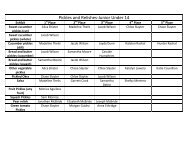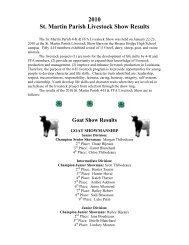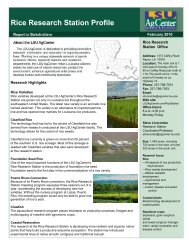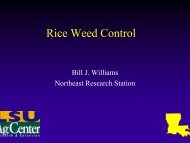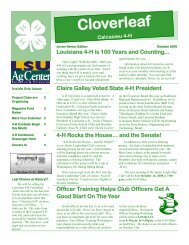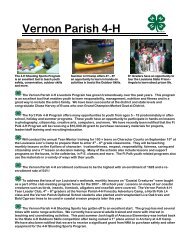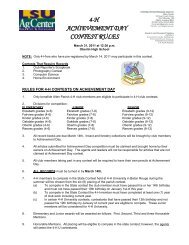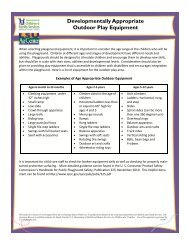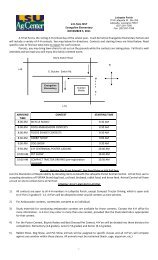Annual Bedding Plants ding Plants for Louisiana â or Louisiana ...
Annual Bedding Plants ding Plants for Louisiana â or Louisiana ...
Annual Bedding Plants ding Plants for Louisiana â or Louisiana ...
Create successful ePaper yourself
Turn your PDF publications into a flip-book with our unique Google optimized e-Paper software.
<strong>Annual</strong><br />
<strong>Bed<strong>ding</strong></strong> <strong>ding</strong> <strong>Plants</strong><br />
<strong>f<strong>or</strong></strong> <strong>Louisiana</strong> —<br />
A Handbook
<strong>Annual</strong><br />
<strong>Bed<strong>ding</strong></strong><br />
<strong>Plants</strong> <strong>f<strong>or</strong></strong><br />
<strong>Louisiana</strong><br />
- A Handbook<br />
Flowering annuals provide much desired<br />
landscaping col<strong>or</strong> in many residential and<br />
commercial plantings. They provide seasonlong<br />
col<strong>or</strong> throughout the year and also add<br />
other characteristics such as foliage col<strong>or</strong>,<br />
<strong>f<strong>or</strong></strong>ms and textures. An annual is defined as a<br />
plant that produces flowers and seeds within<br />
one growing season after planting, then dies.<br />
Sometimes perennials are treated as annuals.<br />
There are several imp<strong>or</strong>tant items to<br />
consider to be successful with bed<strong>ding</strong> plants<br />
in <strong>Louisiana</strong>. These include soil pH, proper<br />
planting depth, irrigation management,<br />
removal of old flowers, planting time, fertilization<br />
management, bed preparation and<br />
cultivar selection. This publication provides<br />
in<strong>f<strong>or</strong></strong>mation to help home gardeners in <strong>Louisiana</strong> with bed<strong>ding</strong> plant selection<br />
and proper care.<br />
Using Flowering<br />
<strong>Annual</strong>s<br />
In the well-planned landscape, annuals should be wisely selected and arranged<br />
to help bring to the landscape a high degree of <strong>or</strong>der.<br />
<strong>Annual</strong>s of many different col<strong>or</strong>s scattered over wide areas destroy the<br />
desired harmony of a planned landscape. Unifying all segments of a total landscape<br />
should be your goal. <strong>Annual</strong>s should be a vital part of the entire area,<br />
rather than a yearly addition to existing plantings.<br />
Col<strong>or</strong>s need to be grouped together. The visual display of one col<strong>or</strong> in a given<br />
area catches the eye m<strong>or</strong>e quickly than a sprinkling of many col<strong>or</strong>s over large<br />
areas. A harmony of col<strong>or</strong>s present at any one season is desirable.<br />
Ease of maintenance is a maj<strong>or</strong> concern. Plant only those you can care <strong>f<strong>or</strong></strong><br />
properly. Planting annuals in one large bed is m<strong>or</strong>e desirable than having small<br />
insignificant beds throughout the landscape.<br />
<strong>Annual</strong>s, because of their versatile nature, are imp<strong>or</strong>tant <strong>f<strong>or</strong></strong> seasonal interest.<br />
They can be selected to provide col<strong>or</strong>ful warmth during winter <strong>or</strong> to give<br />
splend<strong>or</strong> to the garden during the difficult summer months.<br />
The hardiest annuals can be planted during the fall. With little protection,<br />
they will survive the winter and bloom in very early spring. Tender annuals are<br />
planted outdo<strong>or</strong>s in the early spring after danger of frost has passed.<br />
See<strong>ding</strong> and Transplanting<br />
Most annual seeds are very small and should be sown in moist, finely pulverized<br />
soil at a shallow depth.
Plant seeds of tender<br />
annuals indo<strong>or</strong>s two<br />
weeks to one month<br />
be<strong>f<strong>or</strong></strong>e the danger of frost<br />
has passed. This will<br />
ensure early flowering<br />
plants. Fact<strong>or</strong>s affecting<br />
young plants are m<strong>or</strong>e<br />
easily controlled if seeds<br />
are sown indo<strong>or</strong>s.<br />
When the weather will<br />
permit and annuals have<br />
two to four true leaves<br />
per plant, transplant<br />
outdo<strong>or</strong>s. Avoid a shock<br />
of temperature changes<br />
by conditioning the<br />
seedlings to the lower<br />
temperatures be<strong>f<strong>or</strong></strong>e<br />
transplanting them. You<br />
can do this by subjecting<br />
the seedlings to the lower<br />
outdo<strong>or</strong> temperatures be<strong>f<strong>or</strong></strong>e transplanting takes place. If seedlings are left in<br />
dark shaded areas, they will grow into weak, spindly plants. F<strong>or</strong> best results,<br />
transplant on a cool shady afternoon.<br />
Bed Prepar<br />
eparation<br />
Provide well-drained fertile garden loam soil <strong>f<strong>or</strong></strong> annuals. Good internal<br />
drainage is as imp<strong>or</strong>tant as surface drainage. Add peat moss, pine bark <strong>or</strong> a<br />
similar material to beds to improve the soil. If drainage is a problem, raise the<br />
bed and add a generous amount of coarse sand to the bed.<br />
<strong>Annual</strong>s differ in sun and shade requirements. Generally, they thrive best in<br />
areas that receive sunlight during much of the day. Locate the bed in areas that<br />
meet the light requirements of the plants.<br />
Remember that soil pH is imp<strong>or</strong>tant <strong>f<strong>or</strong></strong> bed<strong>ding</strong> plants. The recommended<br />
pH <strong>f<strong>or</strong></strong> most bed<strong>ding</strong> plants is 5.4-6.8. Modify soil pH acc<strong>or</strong><strong>ding</strong> to soil test<br />
recommendations.<br />
Cultivating<br />
ting <strong>Annual</strong>s<br />
Bed preparation goes a long way in achieving a successful col<strong>or</strong> planting in<br />
the landscape. It is very imp<strong>or</strong>tant to keep beds free from weeds. An unkept bed<br />
of annuals adds little to the landscape even though the col<strong>or</strong> is present.
<strong>Annual</strong>s will thrive under a proper program of site selection, bed preparation<br />
and fertilization. Begin a fertilization program at planting. A complete slowrelease<br />
fertilizer can be inc<strong>or</strong>p<strong>or</strong>ated into the landscape bed be<strong>f<strong>or</strong></strong>e planting, <strong>or</strong><br />
it can be broadcast over the bed after planting. Apply at the recommended rate.<br />
Light applications of a water-soluble fertilizer can be made at planting and at<br />
regular intervals thereafter, but are not needed when a slow-release fertilizer is<br />
used properly. Avoid using 8-8-8, 13-13-13 and similar fertilizers in your flowering<br />
annual beds. These do not provide the ideal response desired, and they need<br />
to be applied much m<strong>or</strong>e frequently than do slow-release <strong>f<strong>or</strong></strong>mulations. Remember<br />
that excessive fertilization leads to excessive plant growth and results in<br />
fewer flowers.<br />
Irrigation requirements vary acc<strong>or</strong><strong>ding</strong> to the flowering annual planted. Avoid<br />
overwatering. When n<strong>or</strong>mal rainfall does not provide adequate moisture (about<br />
½ inch to 1 inch a week), supplemental water will be needed. A th<strong>or</strong>ough<br />
soaking is preferred instead of frequent sprinklings.<br />
Pest Control<br />
ol<br />
Insect control is a maj<strong>or</strong> fact<strong>or</strong> in the success <strong>or</strong> failure of any flower garden.<br />
There is hardly a plant grown which is not subject to insect attack at some stage<br />
in its growth. Insects may attack the roots, stems, leaves <strong>or</strong> blossoms. Gardeners<br />
should manage landscape plantings to avoid pest problems and apply pesticides<br />
only when necessary.<br />
A good job of insect control can be accomplished with a few basic insecticides.<br />
Sevin, applied as a spray <strong>or</strong> dust, will control most beetles and caterpillars<br />
that feed on foliage and blooms. Use Sevin <strong>or</strong> Orthene to control stink bugs.<br />
Wirew<strong>or</strong>ms, grubw<strong>or</strong>ms and cutw<strong>or</strong>ms can be controlled by inc<strong>or</strong>p<strong>or</strong>ating<br />
Diazinon in the soil be<strong>f<strong>or</strong></strong>e planting. Malathion <strong>or</strong> Orthene will control aphids,<br />
mealybugs and some spider mites. Use a miticide spray <strong>f<strong>or</strong></strong> hard-to-kill spider<br />
mites such as the two-spotted.<br />
Warm Season <strong>Bed<strong>ding</strong></strong> <strong>ding</strong> <strong>Plants</strong><br />
M<strong>or</strong>e than 80 percent of bed<strong>ding</strong> plants sold <strong>f<strong>or</strong></strong> landscape use in <strong>Louisiana</strong><br />
are classified as warm season annuals. Maj<strong>or</strong> warm season bed<strong>ding</strong> plants include<br />
ageratum, begonias, cockscomb (celosia), coleus, impatiens, marigolds, periwinkle<br />
(vinca), petunia, p<strong>or</strong>tulaca, purslane, salvia and zinnia. Some other warm season<br />
bed<strong>ding</strong> plants, such as sunflowers, t<strong>or</strong>enia (wishbone flower), geraniums,<br />
gomphrena and melampodium are available, too.
Ageratums are not nearly as popular as they were<br />
several years ago. Flower col<strong>or</strong>s<br />
Ageratums<br />
available include blue, white, lavender<br />
and pink. Ageratums are closely<br />
related to the native wildflower blue mist. Plant in sun to<br />
partial shade. Ageratums are a good spring flowering bed<strong>ding</strong><br />
plant, but usually lack desirable heat tolerance to per<strong>f<strong>or</strong></strong>m well<br />
through the summer. Good per<strong>f<strong>or</strong></strong>mance can be expected from<br />
early spring through late June <strong>or</strong> early July in most years.<br />
Begonias remain one of the most popular warm<br />
season bed<strong>ding</strong> plants in <strong>Louisiana</strong>. Depen<strong>ding</strong> on the<br />
Begonias<br />
cultivar selected, begonias will per<strong>f<strong>or</strong></strong>m well in full sun to<br />
shaded areas. Those with green and red foliage are<br />
available. Usually, green foliage cultivars are less tolerant<br />
of full sun than the cultivars with red <strong>or</strong> bronze foliage.<br />
Flower col<strong>or</strong>s include rose, red, white and pink. Good<br />
per<strong>f<strong>or</strong></strong>mance can be expected through the summer with<br />
proper care. Avoid close spacing between plants and<br />
overhead irrigation. This fav<strong>or</strong>s development of stem rot<br />
and root rot. The most commonly planted cultivars in<br />
<strong>Louisiana</strong> are Vodka (bright scarlet), Rum (white with<br />
rose edges), Gin (bright rose-pink), Whiskey (pure white)<br />
and Brandy (clear pink). These are collectively referred<br />
to as the cocktail series.<br />
Cockscomb is commonly<br />
referred to as celosia. Several<br />
Cockscomb<br />
different species and cultivars are<br />
available. Plant in full sun. Cockscomb<br />
is m<strong>or</strong>e tolerant of po<strong>or</strong> soil than are other bed<strong>ding</strong><br />
plants. Flower <strong>f<strong>or</strong></strong>ms include feathers, spikes, plumes and<br />
crested. Flower col<strong>or</strong>s include red, pink, yellow and <strong>or</strong>ange. Cockscomb makes<br />
good fresh and dried cut flowers.
Many new cultivars of coleus have<br />
become available the last several years.<br />
Coleus<br />
Older cultivars generally do best in<br />
shade <strong>or</strong> partial shade, but many of<br />
these new cultivars are referred to as “sun loving” and<br />
per<strong>f<strong>or</strong></strong>m great in full sun. Coleus should be grown <strong>f<strong>or</strong></strong> its<br />
foliage characteristics. Flowering is not desired, so pinch off<br />
flower spikes as they develop. M<strong>or</strong>e in<strong>f<strong>or</strong></strong>mation is available<br />
in Extension publication 2677, “The Col<strong>or</strong>s of Coleus.”<br />
M<strong>or</strong>e impatiens are planted in<br />
the United States than any other<br />
warm season bed<strong>ding</strong> plant. They<br />
Impatiens<br />
are the most recommended<br />
bed<strong>ding</strong> plant <strong>f<strong>or</strong></strong> shady areas.<br />
M<strong>or</strong>ning sun on impatiens is okay, but <strong>f<strong>or</strong></strong> best per<strong>f<strong>or</strong></strong>mance,<br />
shade is needed <strong>f<strong>or</strong></strong> midday and late afternoon.<br />
One common problem with impatiens is tall, leggy growth<br />
caused by excessive sha<strong>ding</strong> and planting too closely together.<br />
If plants become tall, pinch back to reduce height. Impatiens<br />
will be good landscape per<strong>f<strong>or</strong></strong>mers from spring through the<br />
fall.<br />
Marigolds are available in numerous<br />
flower col<strong>or</strong>s and growth habits. French<br />
Marigolds<br />
marigolds are sh<strong>or</strong>ter and produce<br />
small flowers. African marigolds are<br />
taller and produce large flowers. Removing old flowers on<br />
marigolds is imp<strong>or</strong>tant to keep the plants continuously<br />
flowering. Plant marigolds in full sun. Marigolds need to be<br />
irrigated during dry weather, but minimize moisture on flower<br />
petals <strong>or</strong> flower blight will develop. Recommended marigold<br />
cultivars include Discovery, Inca, Excel, Bonanza, Hero, Janie, Antigua and<br />
Perfection.
Periwinkles are commonly called<br />
vinca. These are a fav<strong>or</strong>ite among<br />
Perwinkles<br />
<strong>Louisiana</strong> home gardeners. Plant in<br />
full sun. Irrigation can be limited;<br />
they are very drought tolerant. Numerous flower col<strong>or</strong>s<br />
are available. Periwinkles should not be planted until May.<br />
This late planting allows the soil temperatures to elevate and<br />
reduce root and stem rot problems. Recommended cultivars<br />
include Pacifica and Cooler. A new cultivar that has excellent<br />
potential is the Mediterranean series.<br />
Petunias are a good warm season<br />
bed<strong>ding</strong> plant <strong>f<strong>or</strong></strong> provi<strong>ding</strong> landscape<br />
Petunias<br />
col<strong>or</strong> in the spring. Summer humidity<br />
and temperatures usually are not<br />
fav<strong>or</strong>able <strong>f<strong>or</strong></strong> petunias. In south <strong>Louisiana</strong>, petunias can be used<br />
as a cool season bed<strong>ding</strong> plant <strong>f<strong>or</strong></strong> the fall and winter. Plant<br />
petunias in full sun to slightly shaded areas. Numerous flower<br />
col<strong>or</strong>s and cultivars are available. A good range of flower sizes is<br />
available, too.<br />
P<strong>or</strong>tulaca is also called<br />
moss rose. This bed<strong>ding</strong><br />
P<strong>or</strong><br />
<strong>or</strong>tulaca<br />
plant is drought tolerant,<br />
similar to periwinkles.<br />
Flower col<strong>or</strong>s include <strong>or</strong>ange, red, white, yellow,<br />
pink, salmon, lavender and purple. P<strong>or</strong>tulaca is a good, low maintenance<br />
warm season bed<strong>ding</strong> plant.<br />
Purslane is very closely related<br />
to p<strong>or</strong>tulaca. A good range of<br />
Purslane<br />
flower col<strong>or</strong>s is available. Plant in<br />
full sun and limit irrigation. It is a<br />
good plant <strong>f<strong>or</strong></strong> hanging baskets.
Salvia<br />
Salvia is best adapted to full sun, but<br />
it can adapt to partially shaded areas.<br />
Flower col<strong>or</strong>s include red, white,<br />
salmon, pink and lavender. Salvias usually<br />
do well through the early summer, but they typically cannot be<br />
relied on to per<strong>f<strong>or</strong></strong>m well through the summer and into the fall.<br />
Pinching off old flowers is imp<strong>or</strong>tant. Salvias are good <strong>f<strong>or</strong></strong><br />
attracting hummingbirds. Petal spot is a problem on white<br />
flowering cultivars. Perennial salvias are better per<strong>f<strong>or</strong></strong>mers in<br />
<strong>Louisiana</strong> than annual salvias.<br />
Zinnias do well in <strong>Louisiana</strong> when<br />
rainfall is below average. Plant zinnias<br />
Zinnia<br />
in full sun. Many different flower<br />
col<strong>or</strong>s and growth habits are available.<br />
Some cultivars make good cut flowers. Most are easily established<br />
from seed. Limit irrigation. Leaf spot and other foliar diseases can<br />
cause problems on zinnias.<br />
Cool Season <strong>Bed<strong>ding</strong></strong> <strong>ding</strong> <strong>Plants</strong><br />
Pansies dominate the cool season bed<strong>ding</strong> plant market in <strong>Louisiana</strong>. Other<br />
maj<strong>or</strong> cool season bed<strong>ding</strong> plants include dianthus, snapdragons, viola and<br />
<strong>or</strong>namental kale/cabbage. Alyssum and stock are two cool season bed<strong>ding</strong> plants<br />
growing in popularity.<br />
Dianthus have become one of the most<br />
reliable cool season bed<strong>ding</strong> plants. They<br />
Dianthus<br />
require a slightly higher pH than some<br />
other bed<strong>ding</strong> plants. Plant dianthus in<br />
full sun. Flower col<strong>or</strong> will be good through the late fall and<br />
winter, but the spring flower per<strong>f<strong>or</strong></strong>mance is excellent. Dianthus<br />
will per<strong>f<strong>or</strong></strong>m well through April in <strong>Louisiana</strong>. The recommended<br />
cultivar of dianthus <strong>f<strong>or</strong></strong> <strong>Louisiana</strong> is Telstar, a <strong>Louisiana</strong> Select winner<br />
in 1996.
Kale<br />
Ornamental kale and cabbage are<br />
becoming m<strong>or</strong>e popular <strong>f<strong>or</strong></strong> cool<br />
season landscape plantings. They<br />
are best adapted to full sun <strong>or</strong><br />
partial shade. Foliage is the desired characteristic. Kale is<br />
usually recognized by fringed leaves, and cabbage has<br />
rounded leaves. Flowers are not desired (most <strong>or</strong>namental<br />
kale and cabbage will begin flowering in mid-spring). Be careful<br />
when fertilizing kale and cabbage. Excessive nitrogen applications<br />
lead to cold damage. Recommended cultivars include Peacock, Chiod<strong>or</strong>i and<br />
Osaka.<br />
No other cool-season bed<strong>ding</strong><br />
plant comes close to pansies in<br />
Pansies<br />
popularity. They are best adapted to<br />
full sun. Don’t plant pansies too early<br />
in the fall. Plant pansies around October 15 in n<strong>or</strong>th <strong>Louisiana</strong><br />
and November 1 in south <strong>Louisiana</strong>. Numerous flower col<strong>or</strong>s<br />
and patterns are available. Plant solid col<strong>or</strong>s in masses <strong>f<strong>or</strong></strong> the<br />
best visual effect. Recommended cultivars are Bingo, Majestic<br />
Giant and Crystal Bowl.<br />
Snapdragons are a cool season bed<strong>ding</strong><br />
plant that has good flowering per<strong>f<strong>or</strong></strong>mance<br />
Snapdragons<br />
agons<br />
in late winter and early spring. Plant in full<br />
sun, although snapdragons can tolerate some<br />
limited afternoon shade. Tall, medium and sh<strong>or</strong>t cultivars are available.<br />
Tall cultivars make excellent cut flowers. Numerous flower col<strong>or</strong>s are<br />
available. Recommended cultivars include Tahiti, Liberty, Rocket and<br />
Fl<strong>or</strong>al Showers.<br />
Violas are a dwarf version of pansy,<br />
frequently also referred to as Johnnyjump-ups.<br />
Plant in full sun to some slight<br />
Violas<br />
afternoon shade. Violas are great container<br />
plants. Plant at the same time as pansies.
<strong>Bed<strong>ding</strong></strong> plants <strong>f<strong>or</strong></strong> specific uses<br />
Edging and B<strong>or</strong>ders<br />
Ageratum<br />
Cockscomb<br />
Alyssum<br />
Begonia<br />
Dianthus<br />
Dusty Miller<br />
French Marigolds<br />
Pansy<br />
Petunia<br />
P<strong>or</strong>tulaca<br />
Hanging Baskets<br />
Alyssum<br />
Impatiens<br />
Petunias<br />
Purslane<br />
P<strong>or</strong>tulaca<br />
Fragrant Flowers<br />
Alyssum<br />
Flowering Tobacco<br />
Petunia<br />
Stock<br />
Dianthus<br />
Par<br />
artial Shade to<br />
Shade Locations<br />
Begonia<br />
Coleus<br />
Impatiens<br />
T<strong>or</strong>enia<br />
Hot and Dry<br />
Locations<br />
Periwinkle<br />
Melampodium<br />
Cockscomb<br />
Zinnia<br />
Purslane<br />
P<strong>or</strong>tulaca<br />
Container Plantings<br />
Begonias<br />
Periwinkle<br />
Petunias<br />
Coleus<br />
Pansy<br />
Viola<br />
French Marigolds<br />
T<strong>or</strong>enia
Impatiens<br />
Visit our web site: http://www.agctr.lsu.edu<br />
Allen D. Owings, Associate Specialist, Commercial Nursery Crops and Home Grounds<br />
<strong>Louisiana</strong> State University Agricultural Center, William B. Richardson, Chancell<strong>or</strong><br />
<strong>Louisiana</strong> Cooperative Extension Service, Jack L. Bagent, Vice Chancell<strong>or</strong> and Direct<strong>or</strong><br />
Pub. 2747 (5M) 1/2000<br />
Issued in furtherance of Cooperative Extension w<strong>or</strong>k, Acts of Congress of May 8 and June 30,<br />
1914, in cooperation with the United States Department of Agriculture. The <strong>Louisiana</strong> Cooperative<br />
Extension Service provides equal opp<strong>or</strong>tunities in programs and employment.



